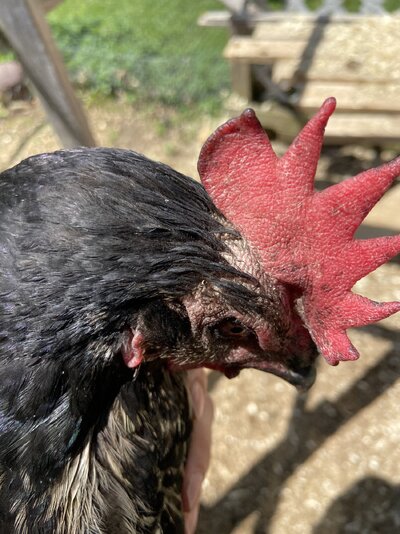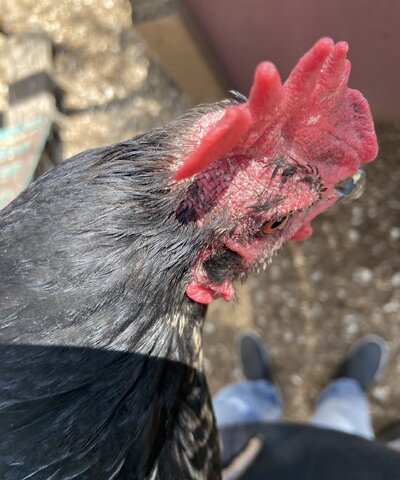Feeling overwhelmed, my whole flock is affected by scaly skin on their combs and faces. Some of them have now lost feathers and their scalps have thickened.
I want to know if anyone can give me a second opinion on the photos I will attach.
Has anyone treated favus successfully? How long did the treatment take and what worked for you? What does your bird look like now having survived this?
Is this even favus!?
Treatment with Miconazole Nitrate 2% since last Sunday, I missed two days of treatment however and the next day things seemed to be even worse.
I’ve washed their faces with a dexidin and water mixture.
They are all dusting every day and I’m unsure if this is helping, hindering the medication, or spreading it around worse.
I first noticed their combs looking dry, and had overlooked it. The miconazole has helped some of the birds but others are suffering worse.
I treated their combs the first couple of days because that was the only areas affected with traces of white stuff and dry looking skin, but rapidly any other exposed skin that I haven’t treated became affected. Such as the area between their eye and nare, eyebrows, cheeks, behind the comb, ect.
This is hell seeing my flock of 11 birds in such conditions.
I brought home a bird with a broken leg at the beginning of April to help a friend out, and it has brought me nothing but trouble despite isolating that bird. She had to be culled because her leg only got worse and now I’m devastated by what I believe is favus.
Please share your stories and advice.
All attached photos are from this morning prior to cleaning and treatment (with the exception of the picture of Fig.)
Some of my birds were missing beards prior to this. I have been dealing with a lot this winter and spring and the battles feel endless.



This is Tusk and she is suffering the worst. The back of her head has thickened and her face is scaling badly. I smear the Miconazole all through the back of her head to try to stop the spread of this horrible stuff.


Yukako has lost feathers behind her comb. She always had big angry eyebrows but I believe the area behind her eye looks thickened and swollen


Kujo, always a baldy for no identifiable reason, but now looking worse. She has no sign of anything last week. I treated her as a preventative measure and then it started…

My sweet Kikyō is almost 6, I absolutely despise that this is happening to her.

Fig’s little comb has been staying clear but now her cheeks and neck has flakes and scabs. I took this photo after wiping her down.

Cheeks, who is missing the feathery cheeks I named her after because of bullying. She is not so badly affected but her face is looking swollen to me.

Dagmar looking horrible. She has been broody for a month and just snapped out of it a couple days ago.

Nausicaä had white traces on her comb and her tiny wattles but seems to be resisting the spread. Her comb is very textured, bumpy, I don’t recall what it used to feel like. She was dust bathing this morning and the dirt really sticks in the rough texture of her comb.
And that’s my story. Any replies are appreciated.
I want to know if anyone can give me a second opinion on the photos I will attach.
Has anyone treated favus successfully? How long did the treatment take and what worked for you? What does your bird look like now having survived this?
Is this even favus!?
Treatment with Miconazole Nitrate 2% since last Sunday, I missed two days of treatment however and the next day things seemed to be even worse.
I’ve washed their faces with a dexidin and water mixture.
They are all dusting every day and I’m unsure if this is helping, hindering the medication, or spreading it around worse.
I first noticed their combs looking dry, and had overlooked it. The miconazole has helped some of the birds but others are suffering worse.
I treated their combs the first couple of days because that was the only areas affected with traces of white stuff and dry looking skin, but rapidly any other exposed skin that I haven’t treated became affected. Such as the area between their eye and nare, eyebrows, cheeks, behind the comb, ect.
This is hell seeing my flock of 11 birds in such conditions.
I brought home a bird with a broken leg at the beginning of April to help a friend out, and it has brought me nothing but trouble despite isolating that bird. She had to be culled because her leg only got worse and now I’m devastated by what I believe is favus.
Please share your stories and advice.
All attached photos are from this morning prior to cleaning and treatment (with the exception of the picture of Fig.)
Some of my birds were missing beards prior to this. I have been dealing with a lot this winter and spring and the battles feel endless.
This is Tusk and she is suffering the worst. The back of her head has thickened and her face is scaling badly. I smear the Miconazole all through the back of her head to try to stop the spread of this horrible stuff.
Yukako has lost feathers behind her comb. She always had big angry eyebrows but I believe the area behind her eye looks thickened and swollen
Kujo, always a baldy for no identifiable reason, but now looking worse. She has no sign of anything last week. I treated her as a preventative measure and then it started…
My sweet Kikyō is almost 6, I absolutely despise that this is happening to her.
Fig’s little comb has been staying clear but now her cheeks and neck has flakes and scabs. I took this photo after wiping her down.
Cheeks, who is missing the feathery cheeks I named her after because of bullying. She is not so badly affected but her face is looking swollen to me.
Dagmar looking horrible. She has been broody for a month and just snapped out of it a couple days ago.
Nausicaä had white traces on her comb and her tiny wattles but seems to be resisting the spread. Her comb is very textured, bumpy, I don’t recall what it used to feel like. She was dust bathing this morning and the dirt really sticks in the rough texture of her comb.
And that’s my story. Any replies are appreciated.






